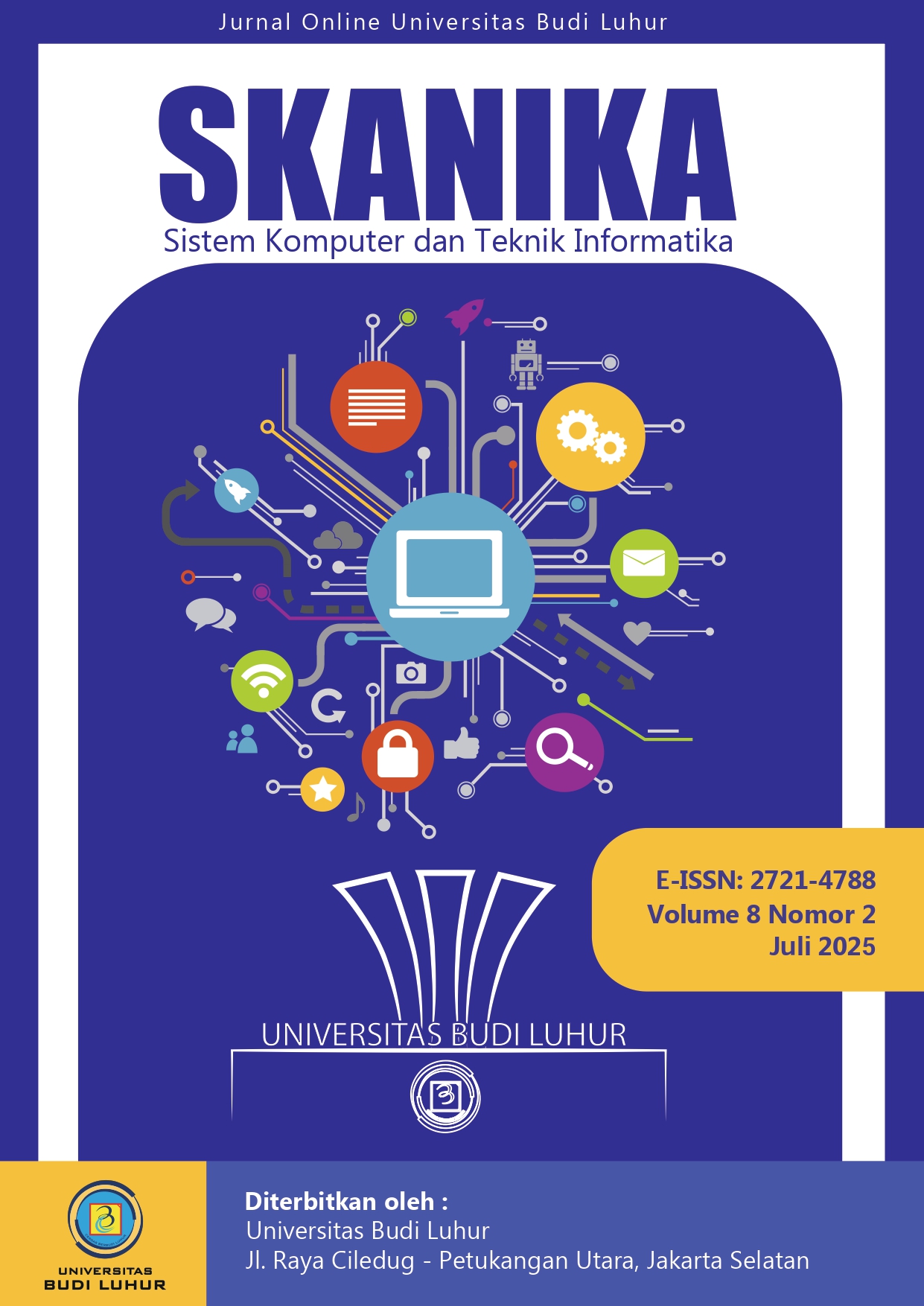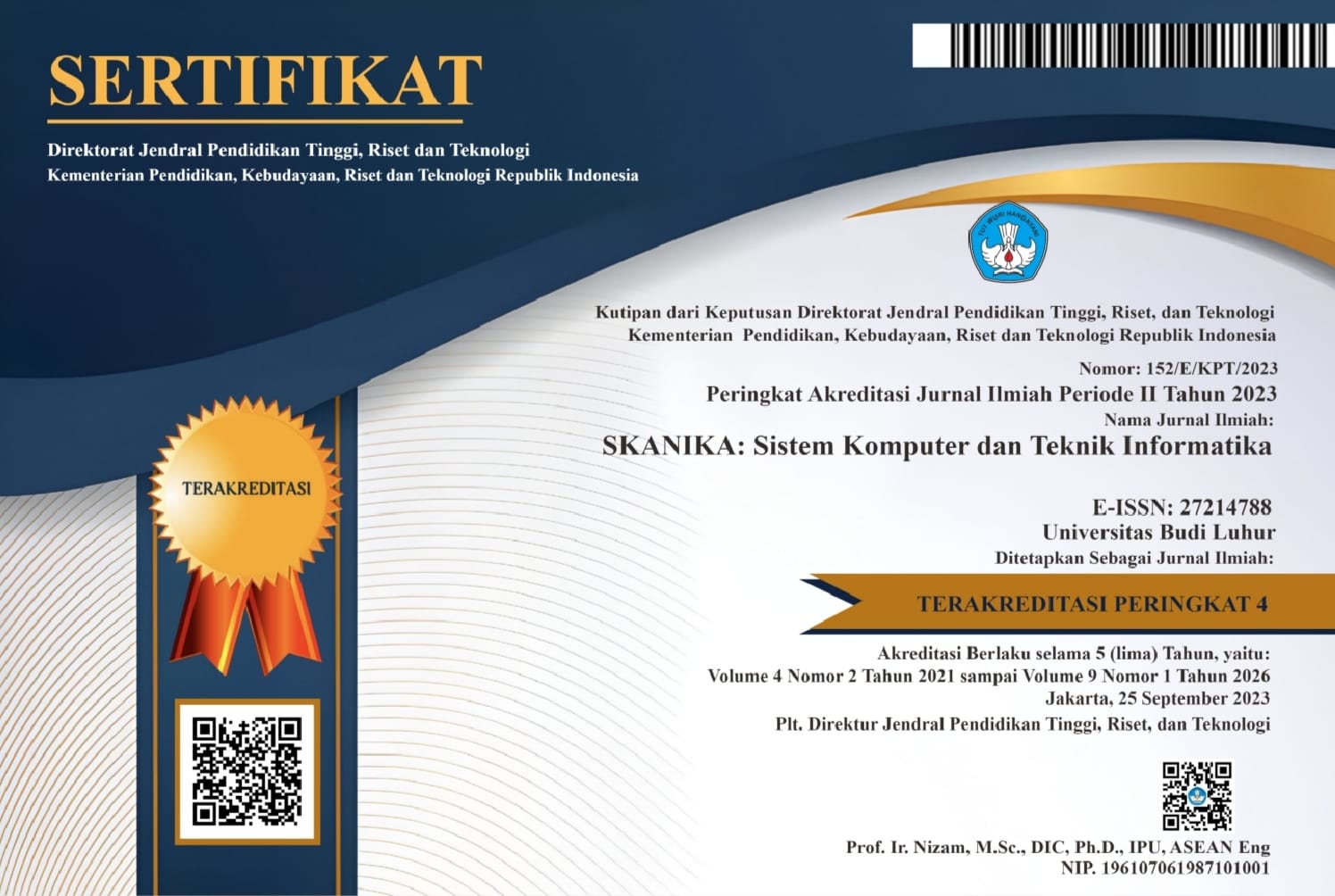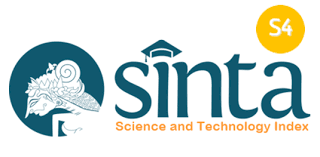KLASIFIKASI KELAYAKAN PENERIMA BANTUAN LANGSUNG TUNAI DANA DESA (BLT DD) MENGGUNAKAN ALGORITMA NAÏVE BAYES DI DESA TARAJU
Bahasa Indonesia
DOI:
https://doi.org/10.36080/skanika.v8i2.3560Keywords:
Naïve Bayes; Classification; Direct Cash Assistance; K-fold cross-validation.Abstract
The Direct Cash Assistance from Village Funds (BLT-DD) program is designed to provide support to rural communities with limited economic means. To ensure that the assistance is properly targeted, the selection process for beneficiaries must be carried out carefully. This study applies the Naïve Bayes algorithm to classify the eligibility of BLT-DD recipients in Taraju Village. Three variants of the Naïve Bayes algorithm were tested, namely Bernoulli Naïve Bayes, Gaussian Naïve Bayes, and Complement Naïve Bayes, using 10-fold cross-validation for evaluation. The results showed that Bernoulli Naïve Bayes achieved the highest accuracy at 91%, followed by Gaussian Naïve Bayes with 90%, and Complement Naïve Bayes with 64%. These findings indicate that Bernoulli Naïve Bayes is more effective in classifying the eligibility of BLT-DD recipients compared to the other two variants.
Downloads
References
[1] Badan Pusat Statistik, “Persentase Penduduk Miskin (P0) Menurut Provinsi dan Daerah” [Online]. Available: https://www.bps.go.id/id/statistics-table/2/MTkyIzI=/persentase-penduduk-miskin--maret-2023.html
[2] Badan Pusat Statistik, “Persentase penduduk miskin Kabupaten Kuningan pada Maret 2024.” [Online]. Available: https://kuningankab.bps.go.id/id/pressrelease/2024/10/07/2901
[3] M. Maspawati et al, “Pengaruh Bantuan Langsung Tunai Dana Desa (BLT DD) Terhadap Kesejahteraan Masyarakat Desa Parenring, Kecamatan Lilirilau, Kabupaten Soppeng,” J. Admin. Soc. Sci., vol. 4, no. 2, pp. 82–96, 2023, doi: 10.55606/jass.v4i2.351.stiayappimakassar.ac.id/index.php/jass/article/view/351/357
[4] A. A. Maryoosh and E. M. Hussein, “A Review: Data Mining Techniques and Its Applications,” Int. J. Comput. Sci. Mob. Appl., vol. 10, no. 3, pp. 1–14, 2022, doi: 10.47760/IJCSMA.2022.V10I03.001
[5] A. Jain et al, “A Review: Data Mining Classification Techniques,” Proc. 3rd Int. Conf. Intell. Eng. Manag. ICIEM 2022, pp. 636–642, 2022, doi: 10.1109/ICIEM54221.2022.9853036.
[6] A. Çınar, “Multi-Class Classification with the Gaussian Naive Bayes Algorithm,” J. Data Appl., vol. 0, no. 2, pp. 1–13, 2024, doi: 10.26650/joda.1389471.
[7] L. N. Darussalam et al, “Algoritma Naive Bayes Untuk Meningkatkan Model Klasifikasi Penerima Program Indonesia Pintar Di Sdn 2 Purwawinangun,” JITET., vol. 13, no. 1, pp. 1129–1237, 2022, doi: 10.23960/jitet.v13i1.5882.
[8] D. A. Huriah and N. D. Nuris, “Klasifikasi Penerima Bantuan Sosial Umkm Menggunakan Algoritma Naïve Bayes,” JATI: Jurnal Mahasiswa Teknik Informatika, vol. 7, no. 1, pp. 360–365, 2023, doi: 10.36040/jati.v7i1.6300.
[9] A. Rahma Putri et al, “Klasifikasi Penerima Bantuan Langsung Tunai Dana Desa Menggunakan Algoritma K-Nearest Neighbor,” JATI., vol. 8, no. 4, pp. 6123–6131, 2024, doi: 10.36040/jati.v8i4.10194.
[10] R. Justan et al,“Penelitian Kombinasi (Mixed Methods),” ULIL ALBAB J. Ilm. Multidisiplin, vol. 3, no. 2, pp. 253–263, Jan. 2024, doi: 10.56799/JIM.V3I2.2772.
[11] A. U. B Anelda et al,“Kualitatif : Memahami Karakteristik Penelitian Sebagai Metodologi,” Jurnal Pendidikan Dasar, vol. 11, no. 2, pp. 341–348, 2023, doi: 10.46368/JPD.V11I2.902.
[12] M. Waruwu et al, “Metode Penelitian Kuantitatif: Konsep, Jenis, Tahapan dan Kelebihan,” J. Ilm. Profesi Pendidik., vol. 10, no. 1, pp. 917–932, 2025, doi: 10.29303/jipp.v10i1.3057.
[13] M. I. Prasetiyowati et al, “Determining threshold value on information gain feature selection to increase speed and prediction accuracy of random forest,” J. Big Data, vol. 8, no. 1, 2021, doi: 10.1186/s40537-021-00472-4.
[14] S. dan Sathyanarayanan and B. R. Tantri, “Confusion Matrix‑Based Performance Evaluation Metrics,” Afr. J. Biomed. Res., vol. 27, no. 4S, pp. 4023–4031, 2024, doi: 10.53555/AJBR.v27i4S.4345.
[15] T. J. Bradshaw et al, “A Guide to Cross-Validation for Artificial Intelligence in Medical Imaging,” Radiol. Artif. Intell., vol. 5, no. 4, 2023, doi: 10.1148/ryai.220232.
[16] Jude Chukwura Obi, “A comparative study of several classification metrics and their performances on data,” World J. Adv. Eng. Technol. Sci., vol. 8, no. 1, pp. 308–314, 2023, doi: 10.30574/wjaets.2023.8.1.0054.
[17] C. Liu et al., “Comparative evaluation of encoding techniques for workflow process remaining time prediction for cloud applications,” J. Cloud Comput., vol. 14, no. 1, 2025, doi: 10.1186/s13677-025-00763-8.
Downloads
Published
How to Cite
Issue
Section
License
Copyright (c) 2025 Neng Sri Lathifah Zulfa, Iffah Athifah

This work is licensed under a Creative Commons Attribution-ShareAlike 4.0 International License.
CC BY-SA 4.0
Creative Commons Attribution-ShareAlike 4.0 International
This license requires that reusers give credit to the creator. It allows reusers to distribute, remix, adapt, and build upon the material in any medium or format, even for commercial purposes. If others remix, adapt, or build upon the material, they must license the modified material under identical terms.
BY: Credit must be given to you, the creator.
SA: Adaptations must be shared under the same terms.ng












